Since the beginning of warfare, there has been specialized terms, acronyms, and soldier slang. This was also true of the LRDG and British Army in the Western Desert. This section is a collection of terms, phrases, slang, initialisms, acronyms, etc. that the LRDG trooper would have been exposed to. The words come from a mix, of Arabic, Italian, German, and English slang.
These same expressions are found on this LRDG site or in the published literature discussing the LRDG. This page is probably the fastest growing page of the site. If you come across a word you are unfamiliar with, either reading a book or browsing this site, check here to see if it is listed. If it isn't listed, feel free to contact me through the Rally Point and I will try to find its meaning and post it.
SEARCH BY ALPHABET
Numbers - A - B - C - D - E - F - G - H - I - J - K - L - M - N - O - P - Q - R - S - T - U - V - W - X - Y - Z
Numbers
- 2 i/c
- Second in Command. Initially the patrols were broken into two half patrols. The OC had charge of the Right Half and the 2 i/c had command of the Left Half. The 2 i/c is the the Assistant Patrol Leader or Executive Officer of the Patrol.
- 25 Pounder
- The backbone of the British Artillery. Cold be used as both artillery and anti-tank gun.
- 77s
- When the war began many people mistakenly called the the 88s a 77. The 7.7cm gun was a German artillery piece from World War I.
- 88s
- German anti-aircraft/anti-tank gun. Considered by many, the best gun the German had. It was not designed as an artillery piece but was sometimes used as such. The 7.5cm howitzer, and 10.5 cm howitzer were the principle artillery guns.
A - Apple
- AFV
- Armoured fighting vehicle.
- 'Ain
- Spring
- Aiwah
- Yes
- Alles
- Literally"all". typically:Everything is Okay
- Alles Kaput
- Everything is messed up, broken
- Alles Plunder
- No cameras, shotguns or binoculars in the village. No souvenirs left
- Alakeefek
- With a Mahleesh (uncaring) attitude
- Akkers
- The field cashier or pay officers
- Ambush
- - A surprise attack against an enemy target. See the Ambush Page for more detail.
- Ammo Boots, Ammunition Boots
- - Standard issue British (and Commonwealth) service boot. This was an ankle-height black leather boot. The British made boot had a toe cap. The canadian version did not. The boots were then given heel and toe irons (plates of metal nailed into the sole) The soles were also hobnailed. Web anklets, known as gaiters, were worn with the boots.
- L'arco dei Fileni de Mussolini
- - The actual name for the Marble Arch in Italian. This was the spot of the longest lasting Road Watch in LRDG history. The Arch of Fileni was built in the Gulf of Sirte, on the border between Tripolitania and Cyrenaica, and included two huge statues depicting the brothers Fileni, legendary Carthaginian heroes who fought alongside the Greeks of Cyrene to define the boundaries between the two civilizations . The Arch was demolished in 1973 by the Libyan government and the two statues now lie at the edges of the road.
- Astrofix
- Same as Star shoot. Using the theodolite to determine your position by observation of the stars.
- Ascaris
- Native Troops
- Autoblinda
- Italian for armoured car. Surprisingly what the Italian tanks lacked their armoured cars made up for. While not capable of withstanding cannon fire, they were reliable, typically had large tyres and were capable machines in the desert. the AB41 and 42 were especially good. One version of the AB42 was used as a pursuit vehicle against the LRDG.
- Automatics, Automatic Pistol
- A self loading hand gun or side arm. Not to be confused with an actual automatic weapon, Automatic pistols are actually semi-automatic in that one pull of the trigger will only fire one round. If a pistol is modified to fire fully automatic, it should be re-classified a submachine gun.
B - Beer
- Ball Ammunition
- Your basic round of ammunition. Others common rounds AP, armor piercing, API, Armor Piercing Incendiary (tracer).
- Balaclavas
- A woolen covering for the head and neck worn esp. by soldiers on active service; named after the Crimean village of Balaclava near Sebastopol, the site of a battle fought in the Crimean war, 25 October 1854. (Similar to knitted caps comforters that were typically worn on patrol and associated more often with Commandos)
- Barchan
- Crescent shaped dune
- BD, Battle Dress
- The British Army European uniform, sometimes called khaki drab, because the uniform is olive brown in color. The 1937 pattern featured a small pocket on the right front hip for a first aid pouch and large cargo pocket on the left hip. The jacket (blouse) features two large breast pockets, and the jacket and trousers can button together in the back. Made of worsted wool and sometimes lined with cotton, the uniform would have been hot in the desert. (See also KD, Khaki Drill)
- Beat up
- To attack a target or to be attacked, depending on the context. This could be a raid or an ambush. A combat mission not RECCE.
- "We had a good beat up on the air field. Six planes blown up and the barracks shot up "
- "We got away from the Autoblindas only to have a beat up with two L3s "
- "The skipper planned a beat up at the cross road where we waited most of the night for a petrol truck to show."
- Bedouin
- One of the Bedu. Bedu, the Arabic word from which the name bedouin is derived, is a simple, straightforward tag. It means "inhabitant of the desert," and refers generally to the desert-dwelling nomads of Arabia, the Negev, and the Sinai. For the LRDG, some of the Bedouin were friendly and some not so friendly. Many just wanted to be left alone. Many also wanted to trade fresh food for cigarettes, candy, food tins and other items of interest. At times they could be a source of important information or aid.
- Bella
- Good
- Bella Seenyoreena
- Good or beautiful woman
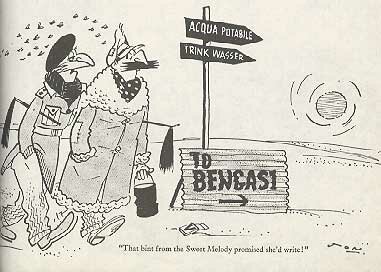
Caption: That bint from the Sweet Melody promised she'd write.
- Bint
- Woman
- Bint Kwoyees
- A good woman, a girl friend, honey.
- Bir
- A well or cistern, often dry
- Bolt Action Weapon
- A weapon that requires the manipulation of a lever (the bolt) in order to chamber a cartridge each time it is to be fired.
- Bono, Kwoyees, Goot
- Good.
- Niente Bono, Mush Kwoyees: no good, bad.
- Molto Bono, Kwoyees Kater, Kwoyees ou wie: Very good.
- Blue, the Ghot.
- Original haunts of the Desert Rats.
- Bombay Bloomers
- A special type of Khaki Drill trousers issued throughout the Desert Campaign. The loose fitting pants could be rolled up and buttoned into shorts that fell just above the knees. When unbuttoned, for an average height soldier they would usually fall to perhaps a few inches above the ankle. While somewhat unpopular they did provide added warmth on cold nights.
- Bully or Bully Beef
- Pickled or tinned beef.
- Brew-Up
- To cook or make tea, to set something afire, destroy or burn down
C - Charlie
- Caford
- A subacute melancholia, characterized by attacks of the 'blues' observed in soldiers
- Caliber
- Bullet size when measured in hundredths of an inch. (Note: This is not what caliber means when discussing artillery)
- Each caliber is 1/100th of an inch. To easily convert from caliber to millimeters or vice versa use the formulas below. (cc=caliber/ mm=millimeter)
For Calibers to Millimeters*
| .cc | X | 25.4 | = | mm |
| some common bullets | ||||
| .50 | X | 25.4 | = | 12.7 mm |
| .38 (.357)* | X | 25.4 | = | 9.0 mm |
| .30 (.303) | X | 25.4 | = | 7.62 mm |
| .2 | X | 25.4 | = | 6.35 mm |
| .45 | X | 25.4 | = | 11.43 mm |
Going from Millimeters to Calibers*
| mm | / | 25.4 | = | .cc |
| some common bullets | ||||
| 14 mm | / | 25.4 | = | 55 calibers |
| 8 mm | X | 25.4 | = | 31 calibers |
| 7.92 mm | / | 25.4 | = | 31 calibers |
| 7.65 mm | / | 25.4 | = | .30 (32 ACP)* |
| 6.5 mm | / | 25.4 | = | .255 (25 ACP)* |
The chart simply gives you an idea of the size of the bullet.
In some cases a bullet is available in both millimeter and caliber. The best examples are the ACP (Automatic Colt Pistol) ammunition. However, most ammunition is made in either calibers or millimeters and does not have an equivalent size in the other category.
Sometimes a bullet's given caliber is not actually the real size of the bullet. This is especially true of the .32 ACP and the .38 Special rounds. The bullets are actually smaller than the stated caliber of the weapon. Both bullets are about two calibers smaller than the given size.
NOTE: In artillery terms, caliber is actually barrel length compared to inside diameter of the barrel
Carabinieri: Italian Police
- Cartridge
- When dealing with small arms, short for ball cartridge. What is often wrongly called a bullet. The cartridge is a round of ammunition containing a projectile (the bullet) a powder charge contained in a casing, and finally a primer which will ignite the powder. If the bullet is not present it is a blank cartridge.
- Caunter Pattern
- An British Camoflage pattern used in North Africa. The scheme was used in 1941-42 and was supposedly developed by Col. Caunter of the 4th armoured Brigade. The scheme was not known by the "Caunter" at the time but as time passed, it became known as the Caunter Pattern. According to some sources, the colors used were: Light Stone, Silver Grey and Slate in a horizontal splinter pattern. Photos often show vehicles with a light blue in the pattern but some authorities say this is actually the silver grey. The silver grey fades to a pale blue.
- Chapplies
- Special leather sandals, often worn on patrol
- Chotts
- Salt lakes
- Charlie Love, Charlie Harry, Charlie Iffer
- Line of departure or rallying point for Guerillas
- Clueless
- No idea of what's going on
- CMP
- Canadian Military Pattern. Vehicles designed for military use in Canada as opposed to civilian vehicles.
- Crusader
- Probably the most important British made tank used in the Desert Campaign. See also Cruiser.
- Cruiser
- Basically what the Americans and Germans called a medium tank, and what today is called a main battle tank. The British had three basic categories of tanks. Fast lightly armored tanks fell into the Cruiser classification. Initially the tanks had a Christie suspension system (torsion bar, larger bogie wheels), thin armor and often nothing more than a two pounder (2 cm) main gun. and a few machine guns. The two most important cruiser tanks operational in North Afrika were the Mk II, Mk III,and the MkIV (Crusader Series). the light American tank, M3, Stuart (Honey) also functioned in the role of a Cruiser tank.
- CV33, CV35, ( More correctly, L3/33, L3/35)
- Italian light tanks or "tankettes". For more information see: L3
- CWT
- A British/Commonwealth abbreviation for Hundred Weight. Thus a 30 CWT was a vehicle capable of towing 3,000 pounds or one and half tons. A 15 CWT is a 3/4 ton vehicle.
- Creased
- Slightly wounded
D - Dog
- Darb el-Arbain (The road of the forty days)
- An ancient slave route beginning at Kobbei (25 miles north of El Fasher) in Darfur to and from Egypt. The route passed through Jebel Meidob, crossing the Libyan dessert through Bir Natrun, and on to Laqiyya, Salima, al Shaff, Kharga to Asyut in Egypt. In total it traversed nearly 1,100 miles of desert and took 40 days march. The route carried commerce of slaves and ivory from Chad and Darfur to Egypt for over 1000 years. today the road is still littered with the bleached bones of camels, horses and humans as the mortality rate among the beasts of burdens and the human cargo was about 80% (Only one out five slaves made it to market. The caravans were estimated to start off with thousands of slaves at a time!)
- Desert Force
- Before the British and Commonwealth forces in the Middle East were officially designated the Eighth Army, they were known as the Desert Force
- Dom Palm
- Hyphaene thebaica, A coastal palm plant also known as African doum palm or gingerbread palm
- Dove sono se (tedesci, cononee, seenyoreena)
- Where are the (Germans, guns, girls)
- Dolce fare niente
- It's nice to do nothing, to be on B3 (leave)
E - Edward
- Erg
- Sand Sea
- 88s
- German anti-aircraft, anti-tank gun. Considered by many, the best gun the German had. It was not designed as an artillery. The 7.5cm howitzer, and 10.5 cm howitzer were the principle artillery guns
F - Fox
- Feloos
- Money, akkers
- Fitter
- - The Fitter is the maintenance vehicle. It carries the necessary supplies to keep the patrol mechanically sound and moving. In the case of the LRDG, this might mean carrying extra carburetors or radiators for the trucks, as well as numerous spare parts such a springs, shocks, and other vehicle parts. The patrols mechanic would be on this vehicle.
- Flimsy
- - A British petrol/water container. They came in varying sizes the most popular being the 4 gallon Flimsy Their shape made them a poor candidate for transporting liquids. However the flimsies came packeged two tins per wodden crate. The flimsies were considered disposable which meant they were used from every thing from trail markers to cooking pans. The wooden crates were a source of fire wood, which was worth its weight in gold in the barren desert. so despite being a poor container for liquids, the flimsies had their advantages over the jerry cans. (Jerry cans were not disposable and therefore continued to take up space and wieght once empty. They also were not pakaged in wood crate.)
- FOB
- Forward Operations Base. A main staging area behind the enemy lines where the LRDG would stage its missions. Typically this was an out of the way area offering protection.
- Force
- Typically a Rading Force put together for a specific mission. The forces are often designated with a letter such as "Force B" or "Force Z". The term almost always refers to Commando or Commando type unit reinforced with a larger body of native forces such as the Sudan Defense Force or in some cases a Commando unit that has mission specific personnel attached to them.
- 4 'n' 1, tracer (four and one, tracer)
- A mix of ammunition, esp. for machine guns where for every four rounds of ball ammunition there is one round of tracer. This was done in order to aid aiming the gun and walking your fire into a target. Other mixes are used but 4 'n' 1 was very common. Sometimes just referred to as 4 'n' 1.
- Frat
- to fraternize with "moffer bints":
- An nice bit of frat or ditto skirt.
- Woman of ill repute, prostitute
- Fucilel Anticarro
- Italian for Anti-tank rifle. The fucile anticarro da 20mm "S" the Swiss made Solothurn S18-1100 Anti-tank rifle in Italian service.
- Fusti
- Fuel can
G - George
- Gebel or Jebel
- Mountain or hill
- Ghibli
- Italian bomber aircraft used by the colonial forces Often used for aerial reconnaissance.
- Gilf
- Cliff or plateau
- Goot Schlappen
- sleep well (really bad German)
- Goum
- a group of irregular forces, Guerillas
- Goumier
- a guerilla fighter.
- Grant
- - American made, Medium Tank, M3, used by the British Army. It was similar to the the M3 Lee Tank used by the Americans , excepting the radio was located in the turret and there was no commander's cupola.
- Gutrah
- (also called Keffiyeh) The Arab Head-dress (the scarf part) that is so commonly associated with the LRDG, and SAS. Typically it was worn more often in camp than on patrol. The agal, is the black bands used to keep the Gutrah in place.
H - Harry
- Hammada
- Stony desert.
- Hatiet, Hatiya
- a patch of vegetation
- Hebron Coat
- A locally acquired goat-skin coat usually black or white in color. The shaggy goat fur was worn on the inside to help insulate the trooper.
- Hooch
- locally made alcohol
- Honey
- - American made, Lt Tank, M3 or M3 Stuart. Later version was the M5, but it did not see service in North Africa.
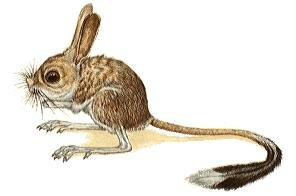
Jerboa
Return to top of pageI - Indigo
- ILRS
- - Indian Long Range Squadron. A four patrol unit of the LRDG.
- Infantry Tank
- The British version of a Heavy Tank. Infantry tank were designed to move with infantry, sacrificing speed for heavy armor. Despite the added weight, the tanks were usually armed with small caliber guns such as 2 or 6 pounders at the time of the Desert Campaign. The most famous used was the Infantry Tank II Matilda. At the beginning of the desert war, the Matilda could take a punch from anything but the dreaded 88, it was known as the Queen of Desert. They were quickly replaced by the US Medium Tank, M3 Grant as they became available.
- Ishi
- Scram
J - Jug
- Jagdpanzer
- Literally Tank Hunter , A turretless version of German tanks often carrying a large caliber gun in the enclosed hull with sloping armour. I am unaware of such vehicles being employed in Afrika. other than the Jagdpanzer I
- Jebel
- Mountains or hilly country
- Jef-jef
- Stony rock-strewn plateau
- Jerboa
- The small desert Kangaroo Rat that became the symbol of the British Soldier in the North African Campaign and later the symbol for the Seventh Armoured Division
- Jerry Can
- - The German 20 liter petrol/water cans. The cans are later copied by Americans and British, and become the standard military issue 5 gallon fuel cans. Typically a white cross was painted on cans used for drinking water or occasionally the word "water" or the letter "W" would just be written in black or white.
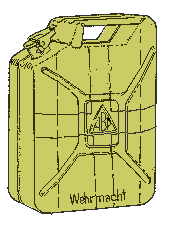
Petrol Can
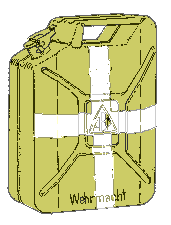
Water Can
Return to top of pageK - King
- Kaput
- destroyed, hopeless, dead
- Kebir
- Big, large.
- Keffiyeh
- (also called Gutrah) The Palestinian/Arab Head-dress (the scarf part) that is so commonly associated with the LRDG, and SAS. Typically it was worn more often in camp than on patrol. The agal, is the black bands used to keep the Keffiyeh in place.
- KD, Khaki Drill
- The British uniform, especially the tan shirt and shorts worn in North Afrika
- Khamseen (Khamsin)
- An oppressive hot wind from the south or south-east, which in Egypt blows at intervals for about 50 days in March, April, and May, and fills the air with sand from the desert.
- Kip
- downtime, a chance to sleep
- Kit
- anything from a soldier's personal equipment to a woman.
- Good kit
- Good equipment, vehicle, woman
- Ropey Kit
- Bad equipment
- Kiwi
- A small flightless bird native to New Zealand. A person who lives or is from New Zealand.
- Kiwi Scorpions
- A term used to describe the LRDG, due to the large number of New Zealanders who formed the unit and the LRDG scorpion emblem
- Kufra
- One of two major oases used by the LRDG during the Desert War. The other oasis was Siwa. (See also online links under Sources)
- Kutch
- niente, nothing
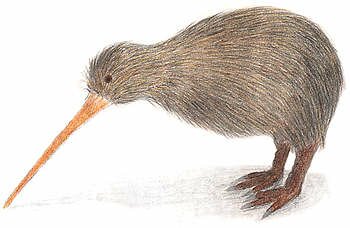
KIWI
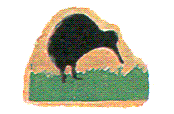
Kiwi marking found on T Ptl.
Return to top of pageL - Love
- (L3/33, L3/35)
- The official term for the Italian light tanks or "tankettes". The were really nothing more than a lightly armed machine gun carrier normally employing twin 8mm machine guns. Some models were upgunned with 12.7 mm or 14.5 mm machine guns. Some were alos armed with the highly effective 20mm Solothurn semi Automatic AT Gun. While virtually useless against other armored vehicles, they were a deadly threat to the light skinned LRDG Trucks. When people talk about knocking out Italian tanks with a rifle these are the ones they are talking about. A Boys AT rifle would easily defeat the armor of these vehicles. . The .5 in MkV Vickers could pentrate at very close range. 303 MG fire might also prove deadly to the light skinned vehicles but not the frontal armor.
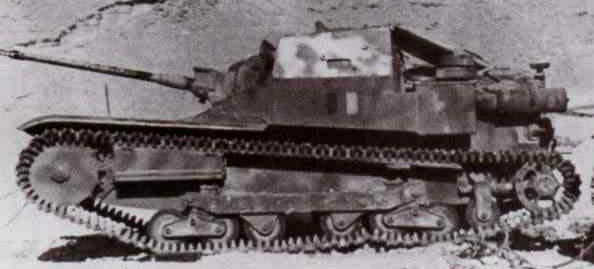
Italian L3/35 with Solothurn 20mm AT rifle, more than a mathc for a Chevy 30CWT!
- L. G.
- Landing Ground
- L'arco dei Fileni de Mussolini
- - The actual name for the Marble Arch in Italian. This was the spot of the longest lasting Road Watch in LRDG history. The Arch of Fileni was built in the Gulf of Sirte, on the border between Tripolitania and Cyrenaica, and included two huge statues depicting the brothers Fileni, legendary Carthaginian heroes who fought alongside the Greeks of Cyrene to define the boundaries between the two civilizations . L'arco fu demolito nel 1973 dal governo libico e le due statue giacciono oggi ai bordi della strada. The span was demolished in 1973 by the Libyan government and the two statues now lie at the edges of the road.
- Lee
- - American made, Medium Tank, M3, used by the American Army. It was similar to the the British Grant Tank, excepting the radio was located in the body of the tank instead of the turret and the commander had a cupola with a .30 caliber MG.
- Liberation
- Complete destruction through bombardment
- To liberate
- To plunder enemy goods
- LP
- - Listening Post. A foward normally occupied at night where patrols would listen for enemy activity. Often the were reloacted OPs (observation posts)
- LRDG
- - Long Range Desert Group.
- LRP
- - LRPU - Long Range Patrol Unit, the forerunner of the LRDG
- LUP
- A Lying Up Position the British term for a Rallying point, forward of the Forward Operations Base(FOB). This could be a smaller base of operation where a patrol would hide while conducting missions or a hasty spot chosen for a quick rest or place to meet in the event of enemy attack. . See also Rallying Point Sometimes called Charlie love, charlie harry or charlie iffey.
- For instance in Lloyd Owen's book and Shaw's 1945 book they use the words "Lie-up" to describe a rallying points. eg: The patrol decided to lie-up and wait for further orders.)
M - Mother
- Ma'aten
- A well.
- Marble Arch
- - The actual name for the Marble Arch in Italian L'arco dei Fileni. This was the spot of the longest lasting Road Watch in LRDG history. The Arch of Fileni was built in the Gulf of Sirte, on the border between Tripolitania and Cyrenaica, and included two huge statues depicting the brothers Fileni, legendary Carthaginian heroes who fought alongside the Greeks of Cyrene to define the boundaries between the two civilizations . The Arch was demolished in 1973 by the Libyan government and the two statues now lie at the edges of the road.
- Matilda
- Next to the Crusader, probably the most important British made tank used in the Desert campaign. See also, Infantry Tank
- M 13/39
- Similar to the M13/40 .it was armed with a 3.7 cm main gun in the HULL , and twin machine guns in the turret. Captured ones were also employed by the Australians for a very short time The armour was also very light. The Boys AT gun could stop this tank.
- M 13/40
- The best of the Italian tanks. armed with a 4.7 cm main gun in a turret , and twin hull machine guns. Captured ones were also employed by the Australians in modest numbers.
- Machine Carbine
- British for submachine gun. also called, submachine carbine.
- Maschinenpistole
- German for submachine gun, literally, Machine Pistol Abbreviated MP.
- Mahleesh
- doesn't matter, couldn't care less, not interested
- Machs Nichts
- doesn't matter, couldn't care less, not interested
- Mehariste
- Camel Corps soldier
- MK III (Mark 3)
- The older version of the SMLE rifle, standard issue to ANZAC forces and common in the British Army until the introduction of the No. 4 Rifle. Not to be confused with the Panzer Mk III, a German medium tank.
- MO
- - Medical Orderly/Officer. On a patrol, this maybe a doctor (medical officer) or perhaps just a highly-skilled medic (medical orderly).
- Moffer
- (Germn Mutter, Mother) Tedeskee, Jerry, Germans, Boche.
- Mofferland
- Used as an insult to describe Germany. (Motherland)
- Moya
- Water, Pahni .
- Mudir
- A native official.
- Mushti
- A chap, a fella, a mate .
N - Nuts
- NAAFI (Navy, Army, Air Force, institutes)
- A uniformed civilian organization within the British Government that oversees the retail sales and entertainment for all branches of the British military. Formed in 1921 and providing a service similar to the American USO, NAAFI provided entertainment canteens and traveling shows for the British soldiers during WWII.
- Niente
- Used in combination with other words to display a negative.
O - Orange
- OC
- - Officer Commanding, Commanding Officer.
- OIC
- - Officer in charge, patrol leader, officer of the day.
- Oozlebart
- Guerrilla, a sniper.
- Operation
- A military mission of some type. RECCE, Ambush, roadwatch, etc
- OP
- - Observation Post. The most forward position of a patrol. Typically a spot where Road Watches were conducted or a small spot where a trooper or troopers would watch for the enemy and provide early warning for the rest of the patrol. At night the position the observation past may be moved to a closer position and become an LP or listening post.
P - Peter
- P-37 (Pattern 37 or 1937 Pattern)
- - The British web gear, that is the equipment harness that was approved for us in 1937, replacing the World War I era 1908 Pattern web gear. The main components of the web gear include the belt, braces (suspenders or shoulder straps), compass/ammunition pouch (for pistol), universal pouch (often called a Bren pouch), bayonet frog, haversack, water bottle carrier, and water bottle (canteen). Other items included pistol holster, binocular case, respirator (gas mask) case, and several other items.
- Panzer
- - Any german armour. In an official report, tanks, self-propelled guns, armoured transport, etc would be identified as specifically as possible. There is a big difference between a PzKfw II (Panzer Kampfwagen II)and a PzKfw IV (Panzer Kampfwagen IV).
- Patrol (Ptl)
- - The fighting units in the LRDG. Eventually the LRDG operated Patrols consisting of six vehicles, each vehicle providing an essential element of the patrol.
- Phonetic Alphabet
- - With the advent of Radio communications a need to clarify letters of the alphabet was quickly discovered. Communications were often less than clear and it was often difficult to distinguish between certain letters such as B and P. Today, there is an international phonetic alphabet that was initially developed by NATO during world War II each nation had its own and in some instances different military branches (army,navy, etc.) had different phonetic alphabets.
- The most often used phonetic alphabet among Commonwealth forces was developed by the British RAF and was used in all theaters. The chart below shows the British RAF phonetic alphabet compared to the American Army and later NATO/Iinternational alphabet
| Letter | RAF WWII | US-WWII | NATO |
| A | Apple | Able | Alpha |
| B | Beer | Baker | Bravo |
| C | Charlie | Charlie | Charlie |
| D | Dog | Dog | Delta |
| E | Edward | Easy | Echo |
| F | Freddy | Fox | Foxtrot |
| G | George | George | Golf |
| H | Harry | How | Hotel |
| I | Indigo | Item | India |
| J | Johnny (or Jug) | Jig | Juliet |
| K | King | King | Kilo |
| L | Love | Love | Lima |
| M | Mother | Mike | Mike |
| N | Nuts | Nan | November |
| O | Orange | Oboe | Oscar |
| P | Peter | Peter | Papa |
| Q | Queen | Queen | Quebec |
| R | Roger (or Robert) | Roger | Romeo |
| S | Sugar | Sugar | Sierra |
| T | Tommy | Tare | Tango |
| U | Uncle | Uncle | Uniform |
| V | Vic (or Victor) | Victor | Victor |
| W | William | William | Whiskey |
| X | X-Ray | X-Ray | X-ray |
| Y | Yorker (or Yoke) | Yoke | Yankee |
| Z | Zebra | Zebra | Zulu |
- Popski's Private Army
- A demolition and recon unit that began as a the Demolition Platoon in the LRDG led by Vladimir Peniakoff, Popski. Popski's army relied heavily on local Arabs and was quite the private army. In some ways he was the Lawrence of Arabia of the WWII Desert War but without the same amount of publicity. He and his army later went on to fight with partisans in Yugoslavia and Eastern Europe.
- Portee
- - Mounting artillery pieces on the bed area of a truck. This was not a true self-propelled gun. It was possible to remove the gun from the truck bed and set it up for firing. The British found success in using the portee system with their two pounder and six pounder anti-tank guns.
- Pz Kfw
- - German abbreviation for Panzer Kampfwagen (literally Armoured Battle wagon) A German Tank. Five main tanks were used in North Afrika
- Pz Kfw I - a light tank, obsolete and used primarily as a command vehicle and a 4.7cm assault gun (Pz.Jg 1)
- Pz Kfw II - also a light tank armed with a 20mm main gun in a turret
- Pz Kfw III - a medium tank armed with 3.7cm gun and later 5.cm gun or 7.5 cm howitzer
- Pz Kfw IV - a medium tank armed with differing 7.5 cm guns
- Pz Kfw VI - also known as the Tiger or Tiger I, a heavy tank armed with an 8.8 cm gun
- Pz Spw
- - German abbreviation PzSpw: Panzer Spähwagen. literallyarmored spy car. This was the German designation for wheeled armored cars. The three most common were
- SdKfz 223, light four wheeled armed with an MG34, typically a communications/command vehicle
- SDKFZ 222, light four wheeled armed with a 20mm semi- auto cannon and MG, scout vehicle
- SdKfz 232, heavy eight wheeled with a 20mm semi automatic cannon and MG, a scout /command vehicle.
- German armored cars were a major headache for the LRDG. When reading about the LRDG, it seems after air attack, armored cars were the biggest threat to the safety of a patrol.
Q - Queen
- Qaret, garet
- a hill
- Qibli
- A hot south wind.
R - Robert
- RA
- - Royal Artillery
- Raid
- - A direct action mission in which a patrol or patrols would make a surprise attack against an enemy position. Unlike other combat missions, a raid is not designed to take ground but is is either used to gain information or destroy or disrupt certain enemy capabilities .
- Rally Point, Rallying Point (RP)
- - American term for LUP or RV. A location designated, usually by the patrol commander as a place for the patrol to reform in the event of dispersal or attack. Rallying points are some times assigned in advance or as the patrol passes a likely spot that is easily recognizable. A good rallying point is easy to defend, offers concealment from enemy observation, and offers an escape route. Typically a rallying point has a "door"; that is a in a single entry point from which all patrol members will enter and exit. By doing this, the patrol knows that if the location is approached from some other direction it is most likely hostile forces.
- A special rallying point is the Advanced Rallying Point. This is called the Objective Rallying Point or ORP in the United States Army. The Advanced Rallying Point is the rally point nearest the objective or target that the patrol is attacking or observing. This is not an observation post. It is the most forward location for the patrol and the place from which they would set up communication with headquarters, and send out road watches and other mission specific patrol elements.
- See also
- LUP.
- Razorbacks
- - Sand dunes with innocent frontal slopes that drop off like a cliff on the back side. Very dangerous for a vehicle moving at any speed.
- RECCE or Recce
- - Reconnaissance mission. Recce Vehicle. Reconnaissance vehicle. Reconnaissance missions are designed specifically to gather information. While in a strict sense all military missions have an intelligence gathering component, the reconnaissance mission is purely for information gathering and all contact with the enemy is avoided unless absolutely necessary. While the patrol would have combat capabilities they are defensive in nature. The idea is not to be discovered or leave evidence that you were in the area.
- Ril
- Addra Gazelle
- Road Watch
- - A common task of the LRDG. A prolonged recce mision involving watching vehicle traffic on a road. See the Kit Bag
- RTR
- - Royal Tank Regiment. The LRDG typically wore black RTR berets with the Scorpion insignia as their unit headgear.
- RV
- Rendezvous or Rendezvous Point. What Americans called a designated Rallying Point.
S - Sugar
- SAS
- - Special Air Service. Unlike the LRDG, the SAS typically operated combat patrols, primarily airfield raids. Today's SAS provide the role originally fulfilled by the LRDG, long range recons and numerous other special operation missions.
- SD (Service Dress)
- The third type of dress wear in the British military. SD is usually reserved for wear when not in combat.
- SDF
- Sudan Defence Force
- Sd Kfz
- Sonder Kraftfahrzeug. Literally Special Military Vehicle. All specially built vehciles used by the German military in WWII had an Sd.Kfz number. Tanks had both a Sd Kfz designation and a Pz Kfw (Panzer Kampfwagen)
- Senussi
- a Muslim religious fraternity founded in 1837 by Sidi Muhammad ibn Ali es-Senussi Often misspelled Sennusi or Sennussi.
- Shmeisser, Schmeisser
- The common name for an MP38 or MP40 German Machine Pistol. A valued souvenir and robust submachine gun. While they may have been plundered, officially, any enemy weapons used by the LRDG were actually reconditioned and issued through proper channels.
- Now before you write me, Schmeisser had nothing to do with the MP38/40. Hugo Schmeisser designed the MP18 Bergman and the MP28,II but the MP38/40 was the creation of Heinrich Vollmer. Schmeisser also went onto to make the world's first assault rifle (MKb42 H which became the MP43 and finally Stg 44). So basically just about every submachine gun and assault rifle used by Germany was designed by Schmeisser except the one called a Schmeisser.
- Siwa
- One of two major oases used by the LRDG during the Desert War. The other oasis was Kufra (See also online links under Sources)
- Shott
- Salt Marsh.
- Sirir, Seris
- A gravel desert
- Smelly
- Slang, most likely modern for the SMLE, Short Magazine Lee Enfield.
- SMLE
- Short Magazine Lee Enfield. Common abbreviation for the British Bolt Action Rifle, especially the No 1 Mk III.
- Shai
- A sweet syrupy drink made brewing tea, sugar, tinned milk and water.
- Shufti
- To observe,
- Shufti Bint
- Look at that woman:
- Shufti Patrol
- A reconnaissance patrol
- Sarkum
- what time is it
- Sarkum Mahleesh
- doesn't matter what time, brew-up
- Shwaya
- Small
- Shlappen
- To sleep, to kip, rest (from the German, Schlafen)
- Shlack Vehter
- Bad weather. (from the German Schlectwetter)
- Skipper
- The patrol commander.
- Star shoot
- Same as Astrofix. Using the theodolite to determine your position by observation of the stars.
- Sturmgeschütz (esp Stug III)
- Literally Storm Gun, or Assault Tank. A turretless version of German tanks often carrying a large caliber gun in the enclosed hull. Similar to Jagdpanzer in design but without sloping armour.
- Submachine gun (SMG)
- Typically, a handheld fully automatic weapon that fires pistol type ammuniton.some have selective fire capabilities but most do not. Full-automatic means that once the trigger is pulled the weapon will continue to fire until the trigger is released or the weapon runs out of ammunition or malfunctions. .
- Submachine guns are also called submachine carbine, machine carbine, and machine pistol
T - Tommy
- Tankettes
- Italian light tanks, especially the CV33. Really nothing more than a lightly armed machine gun carrier employing twin 8mm machine guns. When people talk about knocking out Italian tanks with a rifle these are the ones they are talking about. A Boys AT rifle would easily defeat the armor of these vehicles. .303 MG fire might also prove deadly to the light skinned vehicles.
- Tedesco
- Italian for German
- Terrain chaotique
- French, literally chaotic terrain. Impassible or rough terrain thought to be impassible.
- Theodolite
- A Surveyor's Transit. A portable surveying instrument, originally for measuring horizontal angles, and consisting essentially of a planisphere or horizontal graduated circular plate, with an alidad or index bearing sights; subsequently variously elaborated with a telescope instead of sights, a compass, level, vernier, micrometer, and other accessories, and now often with the addition of a vertical circle or arc for the measurement of angles of altitude or depression. They were essential for getting star readings in order to get an accurate position for the patrol.
- Tibbu, Tebu
- A native of Tibesti
- Tommy
- British Soldier (American Slang)
- Tommy gun
- The Thompson submachine gun, esp. the M1928.
- 25 Pounder
- The backbone of the British Artillery during World War II. It was used as artillery (indirect fire) and also as an anti-tank gun (direct fire).
- Trooper
- A term used throughout these pages to describe members of the LRDG, typically enlisted or other ranks. There is plenty of evidence in the written sources that members of the LRDG referred to each other as trooper or troops.
- Tropal Coat
- A misnomer for the issued overcoat often worn to stop the chill of the desert night. This was not the Standard British Overcoat (Great Coat) but was a coat similar in design that was issued at first to troops sent to Norway. The coat had a Kapok* lining which made it both heavy and uncomfortable. However the coat was very warm. Tropal was the company that produced the coat. It has been called a Tropical coat, a misnomer.
- ( * a silky like fiber derived from the fruit of the silk-cotton tree)
U - Uncle
Return to top of pageV - Vic
Return to top of pageW - William
- Wadi or Wady
- An arabic word for a ravine or valley which in the rainy season becomes a watercourse. Also the stream or torrent running through such a ravine. The wadi could often be strewn with rocks and pebbles similar to a dry stream bed. Wadis would often offer the only cover or concealment for hundreds of miles.
- Wallad
- A boy
- Whale backs
- Smooth rolling sand dunes (see also: Razorbacks)
- W/T
- - Wireless Telephone, Wireless Transmission. A Radio transmitter/receiver.
X - X-ray
Return to top of pageY - Yorker
- Yallah
- Scram
Z - Zebra
- Zawia
- a religious center.
- Zift
- Useless
- Zbib
- Same as hooch
